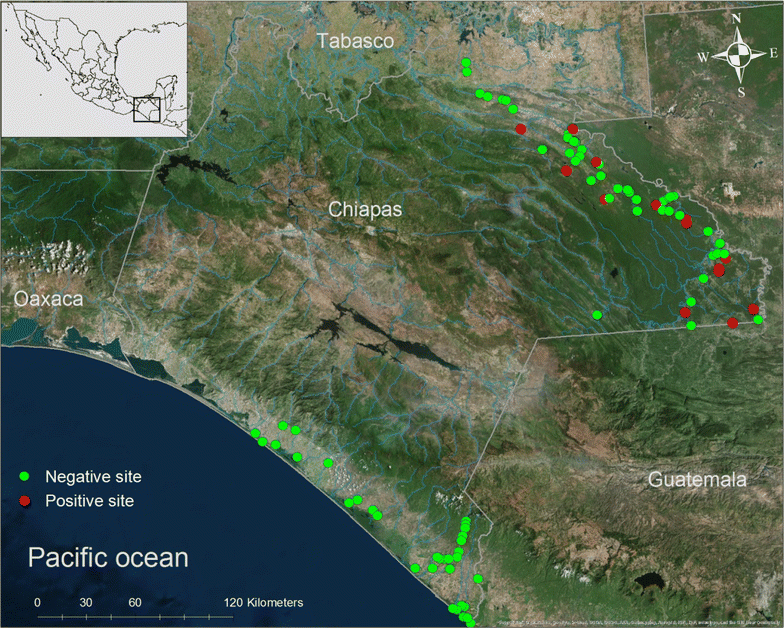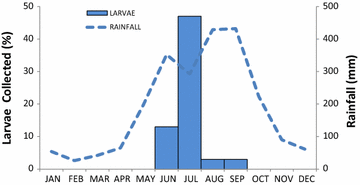Larval habitat characterization of Anopheles darlingi from its northernmost geographical distribution in Chiapas, Mexico
- PMID: 26693816
- PMCID: PMC4688970
- DOI: 10.1186/s12936-015-1037-0
Larval habitat characterization of Anopheles darlingi from its northernmost geographical distribution in Chiapas, Mexico
Abstract
Background: Anopheles darlingi is considered the most efficient malaria vector in the Neotropical region. In Mexico, its role as an incriminated vector of Plasmodium has not been confirmed in the Lacandon forest. Similarly, knowledge about bionomic and larval ecology is scarce. The study aim was to identify and describe the larval habitats of An. darlingi in Chiapas, México.
Methods: Standard larval collections were performed in the Lacandon forest region and in the Soconusco region of southern Chiapas from January 2010 to April 2014, including dry and rainy seasons. Mean larval density of An. darlingi was estimated according to hydrological types, and associations between the presence of An. darlingi and environmental factors including ecological parameters and geographic positions were statistically analysed.
Results: One hundred and twelve aquatic habitats were analysed, 80 from the Lacandon forest region and 32 from the Soconusco region; 94.64% of these sites presented anopheline larvae. In total, 10,977 larvae belonging to 11 Anopheles species were collected. The 19 (out of 112) larval habitats positive to An. darlingi were: rain puddles (26.32%), ground pools (21.05%), ponds (15.79%), ditches (15.79%), river margins (10.53%) and streams (10.53%). Overall, the average (±SD) larval density was 6.60 ± 2.41 larvae per dip. Multiple logistic regression analysis showed that temporary habitats, green algae presence and stagnant water were associated with An. darlingi larval presence. The positive habitats were found in the Lacandon forest region during the rainy season (May-September). No specimens were found in the Soconusco region of the coastal plain of Chiapas.
Conclusion: The mosquito An. darlingi larval habitats were found in different hydrological types. The habitat stability, presence of algae and water current were the main factors for An. darlingi larval occurrence. The information on the characteristics of the larval habitats of An. darlingi will be useful in sustainable programmes for malaria control in the Lacandon forest region, Chiapas.
Figures



References
-
- WHO . World malaria report. Geneva: World Health Organization; 2014.
-
- Faran ME, Linthicum KJ. A handbook of the Amazonian species of Anopheles (Nyssorhynchus) (Diptera: Culicidae) Mosq Syst. 1981;13:1–81.
-
- Knight KL, Stone A. A Catalog of the mosquitoes of the world (Diptera: Culicidae). Thomas Say Foundation Second edition. 1977;6:1–10.
-
- Linthicum KJ. A revision of the Argyritarsus section of the subgenus Nyssorhynchus of Anopheles (Diptera: Culicidae) Mosq Syst. 1988;20:98–271.
Publication types
MeSH terms
LinkOut - more resources
Full Text Sources
Other Literature Sources
Miscellaneous

